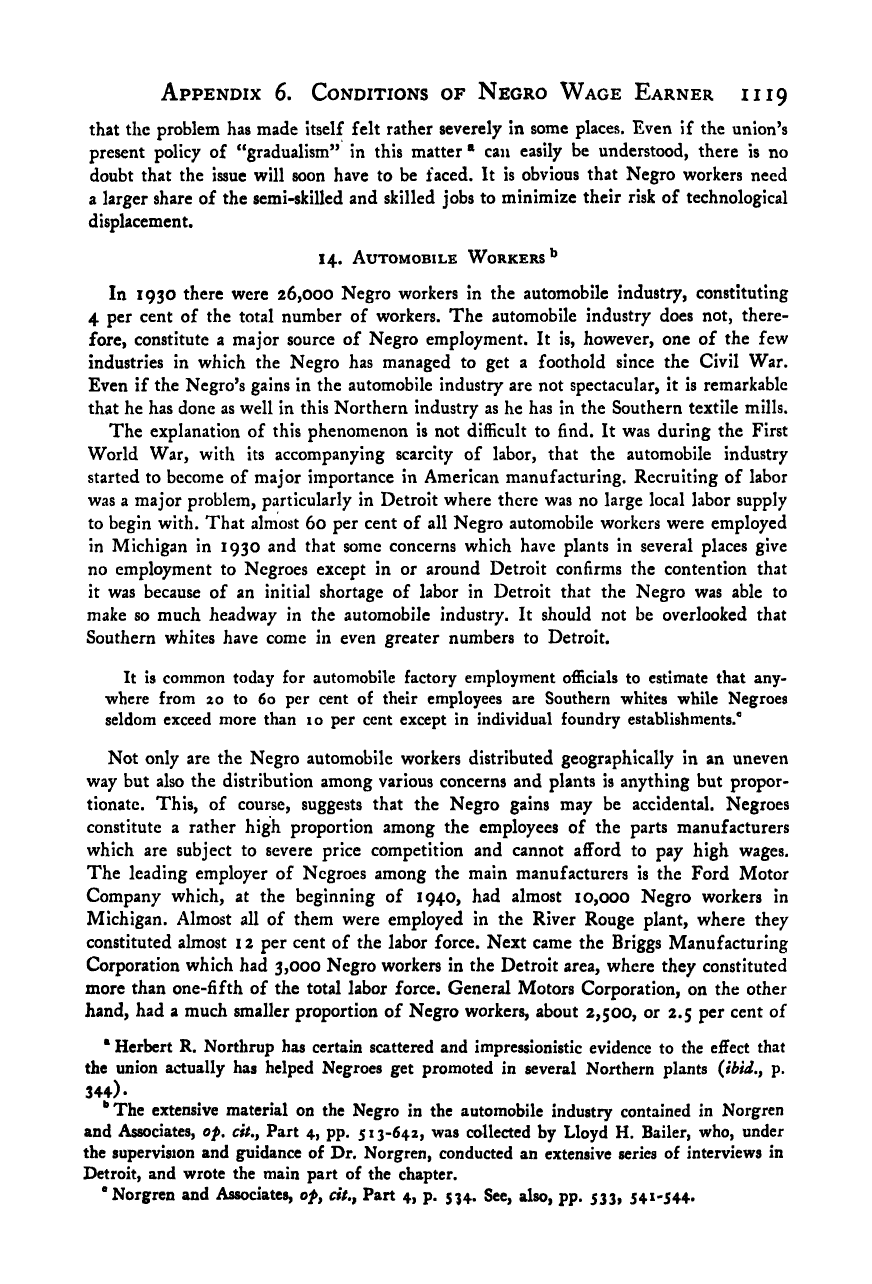Note: Gunnar Myrdal died in 1987, less than 70 years ago. Therefore, this work is protected by copyright, restricting your legal rights to reproduce it. However, you are welcome to view it on screen, as you do now. Read more about copyright.
Full resolution (TIFF) - On this page / på denna sida - Appendices - 6. Pre-War Conditions of the Negro Wage Earner in Selected Industries and Occupations - 13. Iron and Steel Workers - 14. Automobile Workers

<< prev. page << föreg. sida << >> nästa sida >> next page >>
Below is the raw OCR text
from the above scanned image.
Do you see an error? Proofread the page now!
Här nedan syns maskintolkade texten från faksimilbilden ovan.
Ser du något fel? Korrekturläs sidan nu!
This page has never been proofread. / Denna sida har aldrig korrekturlästs.
Appendix 6. Conditions of Negro Wage Earner 1119
that the problem has made itself felt rather severely In some places. Even If the union’s
present policy of “gradualism” in this matter ® can easily be understood, there is no
doubt that the issue will soon have to be faced. It is obvious that Negro workers need
a larger share of the semi-skilled and skilled jobs to minimize their risk of technological
displacement.
14. Automobile Workers’*
In 1930 there were 26,000 Negro workers in the automobile industry, constituting
4 per cent of the total number of workers. The automobile industry does not, there-
fore, constitute a major source of Negro employment. It is, however, one of the few
industries in which the Negro has managed to get a foothold since the Civil War.
Even if the Negro’s gains in the automobile industry are not spectacular, it is remarkable
that he has done as well in this Northern industry as he has in the Southern textile mills.
The explanation of this phenomenon is not difficult to find. It was during the First
World War, with its accompanying scarcity of labor, that the automobile industry
started to become of major importance in American manufacturing. Recruiting of labor
was a major problem, particularly in Detroit where there was no large local labor supply
to begin with. That almost 60 per cent of all Negro automobile workers were employed
in Michigan in 1930 and that some concerns which have plants in several places give
no employment to Negroes except in or around Detroit confirms the contention that
it was because of an initial shortage of labor in Detroit that the Negro was able to
make so much headway in the automobile industry. It should not be overlooked that
Southern whites have come in even greater numbers to Detroit.
It is common today for automobile factory employment officials to estimate that any-
where from 20 to 60 per cent of their employees are Southern whites while Negroes
seldom exceed more than 10 per cent except in individual foundry establishments.®
Not only are the Negro automobile workers distributed geographically in an uneven
way but also the distribution among various concerns and plants is anything but propor-
tionate. This, of course, suggests that the Negro gains may be accidental. Negroes
constitute a rather high proportion among the employees of the parts manufacturers
which are subject to severe price competition and cannot afford to pay high wages.
The leading employer of Negroes among the main manufacturers is the Ford Motor
Company which, at the beginning of 1940, had almost 10,000 Negro workers in
Michigan. Almost all of them were employed in the River Rouge plant, where they
constituted almost 1
2 per cent of the labor force. Next came the Briggs Manufacturing
Corporation which had 3,000 Negro workers in the Detroit area, where they constituted
more than one-fifth of the total labor force. General Motors Corporation, on the other
hand, had a much smaller proportion of Negro workers, about 2,500, or 2.5 per cent of
* Herbert R. Northrup has certain scattered and impressionistic evidence to the effect that
the union actually has helped Negroes get promoted in several Northern plants p.
344)-
" The extensive material on the Negro in the automobile industry contained in Norgren
and Associates, of, ctU^ Part 4, pp. 513-642, was collected by Lloyd H. Bailer, who, under
the supervision and guidance of Dr. Norgren, conducted an extensive series of interviews in
Detroit, and wrote the main part of the chapter.
•Norgren and Associates, o/, Part 4, p. 534. Sec, also, pp. 533, 541-544.
<< prev. page << föreg. sida << >> nästa sida >> next page >>